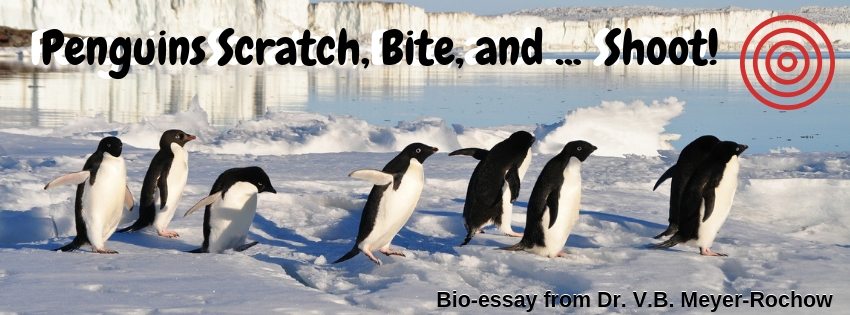Penguins Scratch, Bite, and —- Shoot!
I’ve been on 6 expeditions to Antarctica as a researcher and on one of them I was the leader of the first (and only) Jamaican Antarctic Expedition. We received wonderful support from the Chilean Antarctic Program, but had not much sophisticated equipment. However, apart from preparing samples of Antarctic marine worms and tiny terrestrial insects known as springtails for a study with the electron microscope, we took lots of photographs of penguins.
I showed some of them during a seminar at Kitasato University in Japan and at the end of my talk invited the students to ask questions. A young lady stood up and said: “One of your slides showed a penguin on its nest. Radiating from the edge of the nest were white or pink lines, just like the rays that children draw around the sun. You said penguins decorate their nests, but can you explain how the penguins make these decorations?” Even before I gave my answer, I heard some muffled laughs, but when I explained that a penguin stands up, moves to the edge of its nest, turns around, lifts its tail and then shoots from its rear (which leaves a 30- 40 cm long streak of semi-liquid whitish stuff behind) everybody laughed – with the exception of the questioner: she got red in her face and quietly sat down.
Yet, no question is stupid and this one made me think and look at my slides again. In my collection, I found several pics that had captured penguins “in action”. The lengths of the streaks radiating outward from the nest could be measured easily, the height above the ground of the hole in the penguin from which the faeces were expelled could readily be estimated and even the aperture of the hole, when open, was clearly determinable from two “spot on” shots´. With these data, my colleague Dr. Gal and I began to work. Fortunately, there are some relatively simple formulae to calculate the force behind the end result, i.e. the 30-40 cm long streaks on the ground around the nest. Of course to simplify the equations one has to make some assumptions, for example, that the penguin’s endgut is a stiff tube and the material expelled from there is liquid in nature. Having done that, one arrives at a fair estimate of the pressure exerted by penguins to propel their faeces away, which we published and got Harvard University’s tongue-in-cheek “ig-Nobel” prize for.
One can express this pressure in “Bar”, “Pascal”, “mm mercury” or some other unit, but what it corresponds to is at least one half of the pressure of our cars’ tyres, Not bad for a little fellow one third the size of a human. The colour of the penguin’s faeces stem from the bird’s diet: has it been mainly fish the faeces are white, but were krill shrimps dominating the faeces would turn out pink. The pressing question had been that of the pressure of course, but what still puzzles me is why the streaks were found all around the nest and not just in one direction? Did the penguins choose the direction into which they lifted their tail or did the end result depend on the direction of the wind? I don’t know the answer and perhaps we need a second Jamaica Antarctic Expedition to find out. What I do know is that, compared with seed eaters, the meat and fish-eating birds expel heir faeces with greater force, because their wastes contain higher amounts of uric acid, which is corrosive and irritating: watch an eagle you visit a zoo the next time. But take care where you stand: like penguins these birds can bite – and shoot, from the rear and below the belt!
© Dr V.B. Meyer-Rochow and http://www.bioforthebiobuff.wordpress.com, 2019.
Unauthorized use and/or duplication of this material without express and written permission from this site’s author and/or owner is strictly prohibited. Excerpts and links may be used, provided that full and clear credit is given to V.B Meyer-Rochow and http://www.bioforthebiobuff.wordpress.com with appropriate and specific direction to the original content.

59 thoughts on “Penguins”